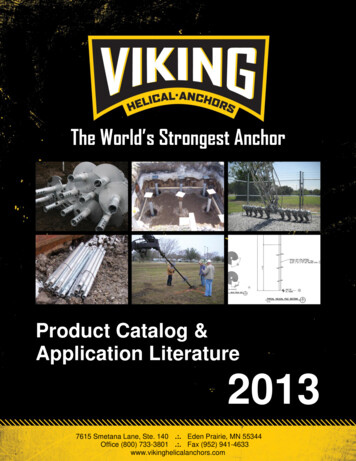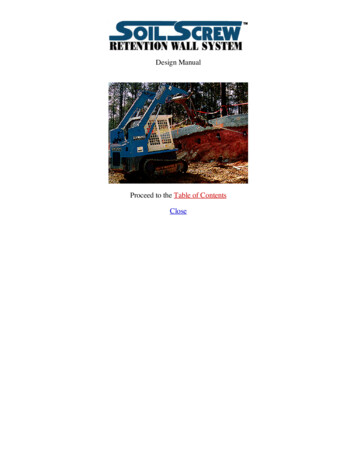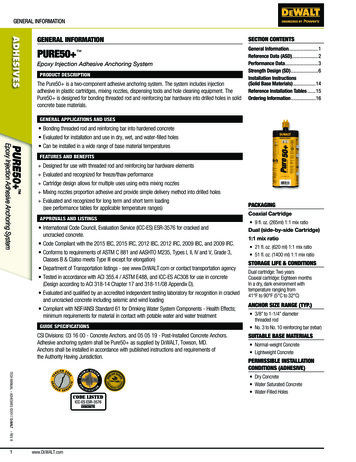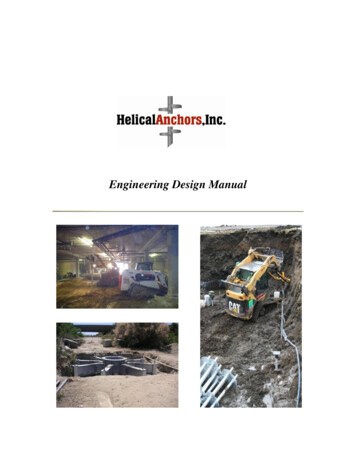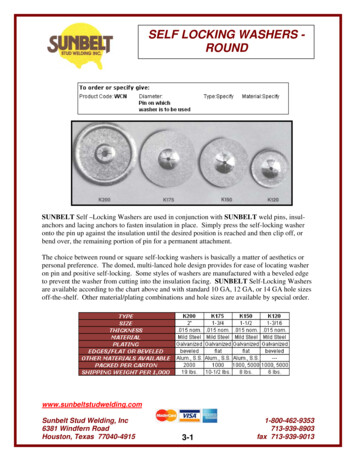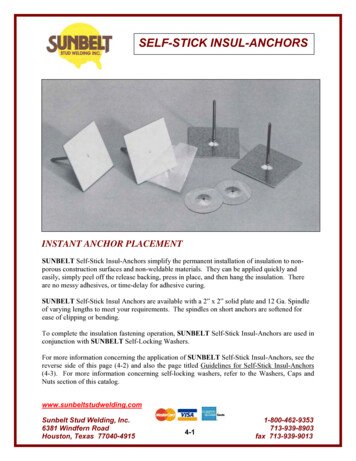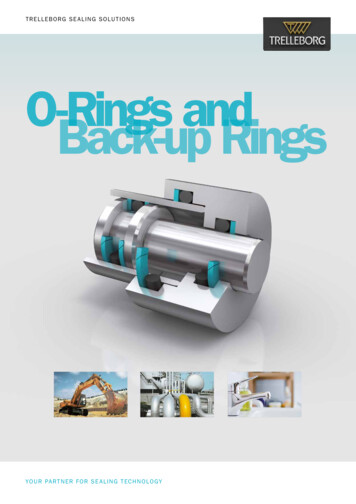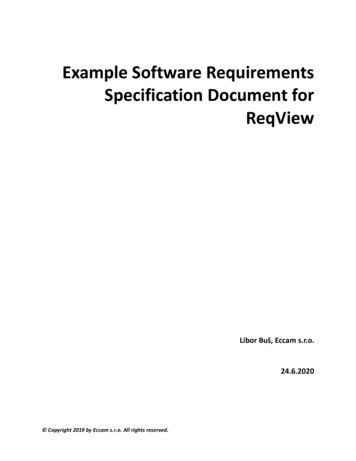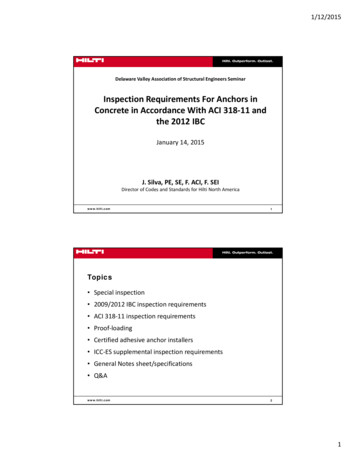
Transcription
1/12/2015Delaware Valley Association of Structural Engineers SeminarInspection Requirements For Anchors inConcrete in Accordance With ACI 318‐11 andthe 2012 IBCJanuary 14, 2015J. Silva, PE, SE, F. ACI, F. SEIDirector of Codes and Standards for Hilti North Americawww.hilti.com1Topics Special inspection 2009/2012 IBC inspection requirements ACI 318‐11 inspection requirements Proof‐loading Certified adhesive anchor installers ICC‐ES supplemental inspection requirements General Notes sheet/specifications Q&Awww.hilti.com21
1/12/2015Topics Special inspection 2009/2012 IBC inspection requirements ACI 318‐11 inspection requirements Proof‐loading Certified adhesive anchor installers ICC‐ES supplemental inspection requirements General Notes sheet/specifications Q&Awww.hilti.com3What is special inspection?1. It is NOT structural observation2009 IBCwww.hilti.com42
1/12/2015What is special inspection?2. It is defined in the code.2009 IBCwww.hilti.com5What is special inspection?2. It is defined in the code.2009 IBCwww.hilti.com63
1/12/2015What is special inspection?4. It can only be performed by a approved inspector NOTemployed or retained by the contractor.2009 IBCwww.hilti.com7Continuous or periodic?2009 IBCContinuous inspection is often viewed as uninterruptedobservation of the work in progress.www.hilti.com84
1/12/2015Continuous or periodic?2012 IBCThe definitions changed materially in the 2012 IBC.www.hilti.com9Where is it called out?The submission ofa specialinspectionschedule is amandatory part ofthe permitprocess.City of San Jose Statement of Special Inspections Formwww.hilti.com105
1/12/2015Where is it called out?The submission ofa specialinspectionschedule is a partof the permitprocess.excerpted fro m Model Program for Special Inspection, ICC/IASwww.hilti.com11Special inspection formsJurisdictionsdevelop their ownrequirements forhow thisinformation is tobe submitted.excerpted from City of San Jose Statement of Special Inspections Formwww.hilti.com126
1/12/2015Special inspection formsJurisdictions develop their own requirements for how thisinformation is to be submitted.excerpted from City of Richmond, Schedule of Chapter 17 Inspectionswww.hilti.com13Special inspection formsJurisdictions develop their own requirements for how thisinformation is to be submitted.excerpted from City of Philadelphia, Statement of Special Inspections Schedulewww.hilti.com147
1/12/2015Topics Special inspection 2009/2012 IBC inspection requirements ACI 318‐11 inspection requirements Proof‐loading Certified adhesive anchor installers ICC‐ES supplemental inspection requirements General Notes sheet/specifications Q&Awww.hilti.com15In the beginning.“.Wherespecialinspection isprovidedvalues may beincreased 100percent.”1976 Uniform Building Codewww.hilti.com168
1/12/20152006 IBCNote that as recently as the 2006 code, inspection was only for cast‐inanchors and then only if you were using increased allowable loads for design(i.e., using a FS of 4 instead of 8!). Per the code inspection was not requiredfor post‐installed anchors or for anchors designed using strength designprovisions, e.g., of ACI 318.www.hilti.com172009 IBCThis was corrected in the 2009 IBC through the addition of a new entry for“anchors installed in hardened concrete”. However, note that continuousinspection for cast in anchors was still required, even for strength design,whereas post‐installed anchors required only periodic.www.hilti.com189
1/12/20152012 IBCIn the 2012 IBC, both cast‐in and post‐installed anchors require periodicinspection, unless otherwise noted as per footnote b.www.hilti.com192012 IBCFootnote b.“b. Specific requirements for special inspection shall be included in theresearch report for the anchor issued by an approved source in accordancewith ACI 355.2 or other qualification procedures. Where specificrequirements are not provided, special inspection requirements shall bespecified by the registered design professional and shall be approved by thebuilding official prior to the commencement of the work.”Sources of additional inspection requirements for anchors: ACI 318 code (2011 and later) ACI 355.4 Evaluation reports (i.e., ESRs)www.hilti.com2010
1/12/2015Summary of special inspection requirementsCode2006 IBC2009 IBC2012 IBCCAST‐IN ASD FS 8NOT REQUIREDNOT REQUIREDNOT REQUIREDCAST‐IN ASD FS 4CONTINUOUSCONTINUOUSPERIODICCAST‐IN STRENGTH DESIGN (e.g.ACI 318 Appendix D)NOT REQUIREDCONTINUOUSPERIODICPOST‐INSTALLEDNOT REQUIREDPERIODICPERIODICPOST‐INSTALLED ADHESIVEQUALIFIED AT A LOWER LEVELADHESIVE ANCHORS NOTINCLUDEDADHESIVE ANCHORS NOTINCLUDEDCONTINUOUS WITH PROOFLOADINGPOST‐INSTALLED ADHESIVE FORSUSTAINED TENSION OVERHEAD TOHORIZONTALADHESIVE ANCHORS NOTINCLUDEDADHESIVE ANCHORS NOTINCLUDEDCONTINUOUS ANDCERTIFIED INSTALLERSAnchor designwww.hilti.com21ACI 318-11 and the 2012 IBCwww.hilti.com2211
1/12/2015If you do work instructures assigned toSDC C, D, E or F, youshould be aware of thisissue.I highly recommendobtaining the article byDr. Ghosh or contactinghim directly at:skghoshinc@gmail.comwww.hilti.com232015 IBCwww.hilti.com2412
1/12/20152015 IBCwww.hilti.com252015 IBCwww.hilti.com2613
1/12/20152015 IBCwww.hilti.com272015 IBCwww.hilti.com2814
1/12/2015Topics Special inspection 2009/2012 IBC inspection requirements ACI 318‐11 inspection requirements Proof‐loading Certified adhesive anchor installers ICC‐ES supplemental inspection requirements General Notes sheet/specifications Q&Awww.hilti.com29ACI 318-11 The 2011 edition of ACI 318 introduced adhesive anchors into the code. This was prompted by the 2006 failure of adhesive anchors securing theceiling of the I‐90 connector tunnel in Boston. The primary concern was for anchors installed overhead and resistingsustained tension loads (e.g., gravity loads).National Transportation Safety Board HAR07‐02www.hilti.com3015
1/12/2015ACI 318-11The ACI code addresses this issue in several ways:1.ALL adhesive anchor systems must be qualified to resist sustainedtension loads. (D.2.3)2.Adhesive anchors to be installed overhead must be qualified foroverhead and horizontal installation. (D.3.4)3.Adhesive anchors subject to sustained tension are subjected to aspecial design check using reduced bond values. (D.4.1.2)4.Adhesive anchors installed overhead and subject to sustainedtension must be installed by certified adhesive anchor installers(D.9.2.2/D.9.2.3) and must be installed under continuous specialinspection. (D.9.2.4)www.hilti.com31ACI 355.4-11 Continuous special inspection for adhesive anchors may also be triggeredby the manner in which they are assessed under the ACI standard ACI355.4 Qualification of Post‐Installed Adhesive Anchors in Concrete (ACI355.4) and Commentary. In such cases, proof loading is also required.Threshold values for anchors subject toperiodic special inspection onlywww.hilti.comThreshold values for anchors subject tocontinuous special inspection and proof loading3216
1/12/2015Topics Special inspection 2009/2012 IBC inspection requirements ACI 318‐11 inspection requirements Proof‐loading Certified adhesive anchor installers ICC‐ES supplemental inspection requirements General Notes sheet/specifications Q&Awww.hilti.com33Proof loading Proof loading of anchors has been practiced in the western U.S. for manyyears as a means of ensuring enhanced quality control for structuresresisting earthquakes. There are no widely recognized standards for proof loading. Proof loading was implemented in the construction of the Big Dig ceilingsystem but the proof loads were quite low (125% of the allowable designload) and the response to anchor failures (as many as 16% of the anchorstested prior to the start of construction failed to resist the proof load)was inadequate. Best practice has been summarized in a document issued by the ConcreteAnchor Manufacturers Association.www.hilti.com3417
1/12/2015Proof loading components1.Proof loads should be established at a level that stresses the anchorwithin the elastic range and does not damage the anchor if it is notdefective. Typical practice in California (OSHPD) is to require proof loadsup to 50% of the permissible bond strength or 80% of anchor yield,whichever is less.2.A representative number of anchors should be tested, depending on thecriticality of the installation. OSHPD typically requires that 50% of allanchors be tested. Rates for non‐hospital work range from 10% to 25%.3.The consequences of any anchor failing the proof load test should beappropriately severe. Typical language requires that the sample rateincrease to 100% if any anchor fails the proof load.4.Proof loads should be applied with a confined test set up.5.Proof load specs should include permissible anchor deflection at proofload, if any. (“No visible movement.”)www.hilti.com35Topics Special inspection 2009/2012 IBC inspection requirements ACI 318‐11 inspection requirements Proof‐loading Certified adhesive anchor installers ICC‐ES supplemental inspection requirements General Notes sheet/specifications Q&Awww.hilti.com3618
1/12/2015Certified installers The requirement for certified installers comes from the ACI code. It is intended to improve the knowledge base of construction personnelinvolved in the installation of adhesive anchors. ACI, in conjunction with CRSI, has developed a certification program foradhesive anchor installers. This certification program is comprised of a written exam and a hands‐on“practice” exam. The exam was developed largely on the basis of Hilti’s experience withtraining of installers of adhesive anchor systems. There is a growing concern that there is/will be a deficit of certifiedinstallers.www.hilti.com37Certified installerswithout piston plugwith piston plugwww.hilti.com3819
1/12/2015Topics Special inspection 2009/2012 IBC inspection requirements ACI 318‐11 inspection requirements Proof‐loading Certified adhesive anchor installers ICC‐ES supplemental inspection requirements General Notes sheet/specifications Q&Awww.hilti.com39Evaluation Service Reports Inspection requirements forpost‐installed anchors are givenin the Evaluation Service Reportsissued by ICC‐ES. These requirements are typicallya summary of requirementsfound in other sections of theIBC and ACI codes, but may alsoinclude requirements orclarifying language not stated inthose documents.ESR‐2322www.hilti.com4020
1/12/2015Topics Special inspection 2009/2012 IBC inspection requirements ACI 318‐11 inspection requirements Proof‐loading Certified adhesive anchor installers ICC‐ES supplemental inspection requirements General Notes sheet/specifications Q&Awww.hilti.com41General notes and specifications Correctly referencing quality control requirements for anchors in theconstruction documents can greatly enhance construction quality andprevent change orders.www.hilti.com4221
1/12/2015General notesBasic requirements for anchoring are often placed on the S1 sheet.www.hilti.com43General notesProof load requirements are often stated in the General Notes.www.hilti.com4422
1/12/2015General notesIt is useful to emphasize that the manufacturers printed instructions (MPII)should be followed. This is also stressed in the anchor installer training.www.hilti.com45General notesProof loads are often shown in tabular form:www.hilti.com4623
1/12/2015SpecificationsAnchor specifications are usually found in 03 15 00 Concrete Accessorieswww.hilti.com47SpecificationsInstaller training and certification is addressed under Quality Assurance.www.hilti.com4824
1/12/2015SpecificationsRequirements on anchor installation are found under Execution.www.hilti.com49Topics Special inspection 2009/2012 IBC inspection requirements ACI 318‐11 inspection requirements Proof‐loading Certified adhesive anchor installers ICC‐ES supplemental inspection requirements General Notes sheet/specifications Q&Awww.hilti.com5025
1/12/2015For discussion1.Do you use adhesive anchors for safety‐related structural applications?2.Do you specify adhesive anchors with confidence?3.Do you agree with the requirement for certified installers?4.Would you require certification for all critical installations or just thosemandated by the code?5.How can the certification program be improved?www.hilti.com5126
ACI 318-11 The 2011 edition of ACI 318 introduced adhesive anchors into the code. This was prompted by the 2006 failure of adhesive anchors securing File Size: 1MB
